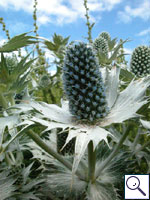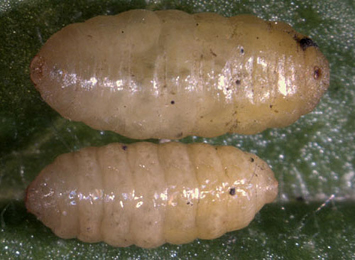|
||||||
|
ERYNGIUM. Sea-holly and Eryngo. [Apiaceae] |
|
|
Six species of Eryngium are recorded in Britain. These include the native Sea-holly (E. maritimum) and Field Eryngo (E. campestre). Field Eryngo (E. campestre) is protected under Schedule 8 of the Wildlife and Countryside Act, 1981. Two British miners are recorded on Eryngium. A key to the European miners recorded on Eryngium is provided in Bladmineerders van Europa. |
 Sea-holly Eryngium maritimum |
Key for the identification of the known mines of British |
1a > Leaf-miner: A distinctive mine primarily above mid-rib, with irregular short lateral offshoots into leaf blade. Pupation external (Spencer, 1972: 51 (fig. 172), 55; Spencer, 1976: 270, 271 (fig. 486)). Branched, whitish, upper-surface corridor; main axis overlying the midrib; side branches overlying the main lateral veins. (In Campanula and Phyteuma the mine is much less branched, sometimes nothing more than a corridor on top of the midrib). Frass in rather long strings. Usually the mines begins as a long and narrow, shallow, tortuous lower-surface corridor that ends upon the midrib but otherwise is not associated with the leaf venation. Often this initial corridor is filled with callus, and then even less conspicuous. Pupation outside the mine. A linear mine on the upper surface, usually following the midrib and showing side branches along the veins. The frass is in strings. |
|
Liriomyza strigata (Meigen, 1830) [Diptera: Agromyzidae]. |
1b > Leaf-miner: Mine linear, whitish, both upper and lower surface. Pupation internal, at the end of the mine with the anterior spiracles projecting through the epidermis (Spencer, 1976: 433). Upper-surface, less often lower-surface corridor. Frass in isolated grains. Pupation within the mine, in a, usually lower-surface, pupal chamber. A long whitish upper surface corridor, which eventually goes lower surface. |
|
Chromatomyia horticola (Goureau, 1851) [Diptera: Agromyzidae]. |
1c > Leaf-miner: A large blotch, yellow or brown, preceded by a short corridor that in the end mostly is completely overrun. Generally several larvae share a mine. Especially in fresh mines the green primary and secondary feeding lines are well visible. Pupation outside the mine. Puparium yellow. |
 Euleia heraclei pupariria Image: © Willem Ellis (Bladmineerders van Europa) |
|
Euleia heraclei (Linnaeus, 1758) [Diptera: Tephritidae]. |
| Last updated 04-Jul-2019 Brian Pitkin | ||
